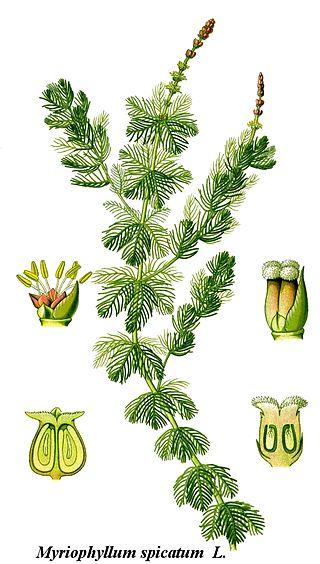
Hamamelidales is an order of flowering plants formerly accepted in a number of systems of plant taxonomy, including the Cronquist system published in 1968 and 1988. The order is not currently accepted in the Angiosperm Phylogeny Group III system of plant taxonomy, the most widely accepted system as molecular systematic studies have suggested that these families are not closely related to each other. The APG II system (2003) assigns them to several different orders: Hamamelidaceae and Cercidiphyllaceae to Saxifragales, Eupteleaceae to Ranunculales, Platanaceae to Proteales, and Myrothamnaceae to Gunnerales. Additional studies of the chloroplast genome have since confirmed that the families moved into the Saxifragales are closely related.

Ranunculales is an order of flowering plants. Of necessity it contains the family Ranunculaceae, the buttercup family, because the name of the order is based on the name of a genus in that family. Ranunculales belongs to a paraphyletic group known as the basal eudicots. It is the most basal clade in this group; in other words, it is sister to the remaining eudicots. Widely known members include poppies, barberries, hellebores, and buttercups.

Proteales is an order of flowering plants consisting of three families. The Proteales have been recognized by almost all taxonomists.

Ceratophyllaceae is a cosmopolitan family of flowering plants including one living genus commonly found in ponds, marshes, and quiet streams in tropical and in temperate regions. It is the only extant family in the order Ceratophyllales. Species are commonly called coontails or hornworts, although hornwort is also used for unrelated plants of the division Anthocerotophyta.

The Buxales are a small order of eudicot flowering plants, recognized by the APG IV system of 2016. The order includes the family Buxaceae; the families Didymelaceae and Haptanthaceae may also be recognized or may be included in the Buxaceae. Many members of the order are evergreen shrubs or trees, although some are herbaceous perennials. They have separate "male" (staminate) and "female" (carpellate) flowers, mostly on the same plant. Some species are of economic importance either for the wood they produce or as ornamental plants.

Hamamelidaceae, commonly referred to as the witch-hazel family, is a family of flowering plants in the order Saxifragales. The clade consists of shrubs and small trees positioned within the woody clade of the core Saxifragales. An earlier system, the Cronquist system, recognized Hamamelidaceae in the Hamamelidales order.

Nelumbonaceae is a family of aquatic flowering plants. Nelumbo is the sole extant genus, containing Nelumbo lutea, native to North America, and Nelumbo nucifera, widespread in Asia. At least five other genera, Nelumbites, Exnelumbites, Paleonelumbo, Nelumbago, and Notocyamus are known from fossils.

The Polemoniaceae are a family of flowering plants consisting of about 27 genera with 270–400 species of annuals and perennials native to the Northern Hemisphere and South America, with the center of diversity in western North America.

Apertures are areas on the walls of a pollen grain, where the wall is thinner and/or softer. For germination it is necessary that the pollen tube can reach out from the inside of the pollen grain and transport the sperm to the egg deep down in the pistil. The apertures are the places where the pollen tube is able to break through the pollen wall.

The eudicots, Eudicotidae, or eudicotyledons are a clade of flowering plants (angiosperms) which are mainly characterized by having two seed leaves (cotyledons) upon germination. The term derives from dicotyledon. Historically, authors have used the terms tricolpates or non-magnoliid dicots. The current botanical terms were introduced in 1991, by evolutionary botanist James A. Doyle and paleobotanist Carol L. Hotton, to emphasize the later evolutionary divergence of tricolpate dicots from earlier, less specialized, dicots.

The rosids are members of a large clade of flowering plants, containing about 70,000 species, more than a quarter of all angiosperms.
Ctenolophon is the only genus in the flowering plant family Ctenolophonaceae. It has two recognized species:

Myrothamnus is a genus of flowering plants, consisting of two species of small xerophytic shrubs, in the southern parts of tropical Africa and in Madagascar. Myrothamnus is recognized as the only genus in the family Myrothamnaceae.
The APG II system of plant classification is the second, now obsolete, version of a modern, mostly molecular-based, system of plant taxonomy that was published in April 2003 by the Angiosperm Phylogeny Group. It was a revision of the first APG system, published in 1998, and was superseded in 2009 by a further revision, the APG III system.

Haloragaceae is a eudicot flowering plant family in the order Saxifragales, based on the phylogenetic APG system. In the Cronquist system, it was included in the order Haloragales.

Droseridites is a genus of extinct plants of possible droseracean or nepenthacean affinity. It is a form taxon known only from fossil pollen. Species assigned to this genus originate from numerous regions of the world, including Europe, India, Egypt, the Arabian Peninsula, and the Kerguelen Islands.

The basal angiosperms are the flowering plants which diverged from the lineage leading to most flowering plants. In particular, the most basal angiosperms were called the ANITA grade, which is made up of Amborella, Nymphaeales and Austrobaileyales.

Mesangiospermae is a clade of flowering plants (angiosperms) that contains about 99.95% of all angiosperm species. Mesangiosperms are therefore known as the core angiosperms, in contrast to the earlier-diverging species known as the basal angiosperms. Mesangiospermae includes about 350,000 species, while there are about 175 extant species of basal angiosperms.

In phylogenetic nomenclature, the Pentapetalae are a large group of eudicots that were informally referred to as the "core eudicots" in some papers on angiosperm phylogenetics. They comprise an extremely large and diverse group accounting for about 65% of the species richness of the angiosperms, with wide variability in habit, morphology, chemistry, geographic distribution, and other attributes. Classical systematics, based solely on morphological information, was not able to recognize this group. In fact, the circumscription of the Pentapetalae as a clade is based on strong evidence obtained from DNA molecular analysis data.


















